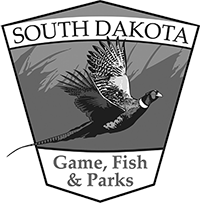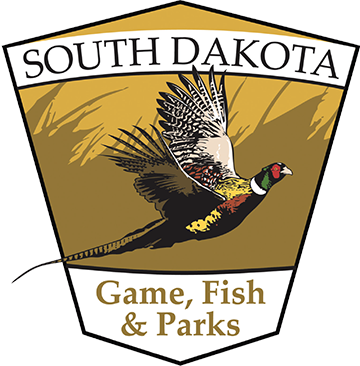Shoreline Alterations
A popular activity for many lakeshore residents is to modify their lake front property. However, it is important for lakeshore residents to understand that a permit may be required from Game, Fish and Parks (GFP) if they are planning on working near or below the Ordinary High-Water Mark (OHWM).
Ordinary High-Water Mark
- The OHWM is the line on the shore where water makes contact on a regular basis.
- On meandered lakes, the shoreline below the OHWM is public.
- Ordinary High-Water Mark example
- On many lakes, the Ordinary High-Water Mark has been formally set and can be found on the Department of Agriculture and Natural Resource dashboard.
- Permanent structures below the OHWM are not allowed.
- The OHWM for an impoundment is the spillway crest elevation.
Laws and Regulations
- It is declared that all water within the state is property of the people of the state, but the right to the use of water may be acquired by appropriation, as provided by law.
- Ownership of land below the water of a navigable lake or stream is regulated by the laws of the state.
- GFP can adopt rules for implementation of game, fish and conservation laws. This includes the management, use and improvement of all meandered lakes, sloughs, marshes and streams extending to and over dry or partially dry meandered lakes, sloughs, marshes and streams, including all lands to which the state has acquired any right, title or interest for the purpose of water conservation or recreation.
- No person may modify shore or bottom lands below the OHWM of meandered waters or other waters to which the state has acquired a right, title, or interest without permission of the GFP
Getting Started
No person shall proceed with any work on, or alteration or disturbance of a lake, lakebed, or lakeshore until he/she has obtained, and has possession of a valid "Shoreline Alteration” permit issued by GFP.
The person who performs or authorizes such work and/or the property owner are responsible for assuring that a valid permit has been obtained from GFP.
Activities regulated by GFP may include any of the following when conducted within the lake, lakebed or lakeshore and will result in an alteration of a lake's bed or shoreline. Example activities for which a permit will be required include, but are not limited to:
- Construction of ditches or channels.
- Dredging or excavation to remove muck, sediment, or rock.
- Seawall installation or seawall refacing.
- Construction of retaining walls and breakwaters.
- Rip rap installation along the shoreline.
- Construction of elevated structures, (ex. decks, overhangs, bridges), that may impair navigability and/or the installation of permanent in-water structures (piers, docks, etc.).
- Filling, including artificial beach creation.
- Stockpiling brush, trees, vegetation, construction materials or debris in the lake or on shore.
- Mechanical or chemical removal or clearing of aquatic vegetation. Manual removal does not require a permit.
- Any other activity, not herein mentioned, that may have an impact on the lake, lakebed or lakeshore.
Activities, like those listed above, will be viewed by the GFP as a taking of the lakebed and are, therefore, contrary to the codified laws listed above. These laws collectively state that the public has a vested right in the preservation, protection, and enjoyment of all public waters and requires the State to hold and control the lakes, in trust, for the use of all citizens. It is the GFP’s position that projects of this nature cannot be approved unless the applicant can clearly demonstrate that a substantial public benefit will result due to the project's construction.
Any person that performs work in the lake, lakebed or lakeshore without a permit for that work shall restore the lake, lakebed or lakeshore to its original condition before he/she disturbed it.
Shoreline Alteration Permit Application
Any person wishing to do work in a lake, lakebed or lakeshore shall submit a complete application to GFP.
The application should be accompanied by a vicinity map, photos, site plan, and project drawings. If needed, the applicant may be required to submit additional information to adequately evaluate the proposal.
Project Evaluation Criteria
In evaluating a proposed project, GFP staff will assess both its singular and cumulative impact on the lake and its resources by looking at impacts to natural resources, natural scenic beauty, and recreational purpose. These terms are defined as follows:
Natural resources: means the water, fish, plant life, and minerals in public waters.
Natural scenic beauty: means the natural condition as left by nature without manmade additions or alterations.
Recreational purpose: means fishing, boating, swimming, and the storage of water to maintain water levels.
The criteria evaluated during a project’s assessment include whether or not the project will:
- Result in a taking of the lake, lakebed or lakeshore;
- Diminish water quality;
- Diminish habitat for fish or wildlife;
- Result in significant environmental harm to the lake;
- Adversely impact navigation or other lawful recreation;
- Create a public nuisance or public safety hazard; or
- Alter the natural characteristics or the shoreline.
The permit will be valid for a period of one (l) year from the date of issuance unless otherwise stated. All construction should be completed prior to expiration of the permit. The permit may be renewed without submission of a new application or plans if the applicant needs more time to complete the already permitted activity. Any new or additional activity, however, will require a new permit.
Note to Applicants: A permit for shoreline alteration issued through GFP does not eliminate the requirement that you obtain any other applicable federal, state, tribal or local permits for your project. Specifically, if any work is occurring in waters of the United States, authorization in the form of a 404 permit will be needed from the United States Army Corps of Engineers.
Contact Us
Please contact your local Aquatic Habitat and Access Biologist with any questions you may have about shoreline alteration permits.

